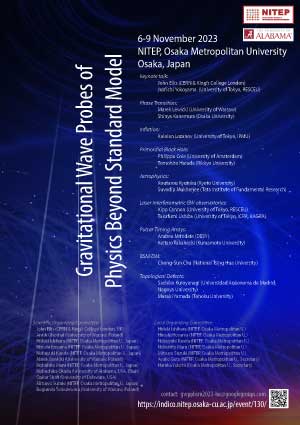Gravitational Wave Probes of Physics Beyond Standard Model
10th floor, Media Center, Osaka Metropolitan University
Registration is now OPEN! (Deadline: Oct. 9th)
Registration is closed.
Detailed timetable is now available. (ver. Nov. 2)
The purpose of this workshop is to discuss how gravitational waves may serve as tools to explore possible fundamental physics beyond the Standard Model, such as first order phase transitions in the early Universe, cosmic strings, primordial black holes and scenarios for cosmological inflation. In addition, it will explore how gravitational wave signals may reveal possible modifications of general relativity. With these aims in mind, the workshop will bring together experts in particle physics, cosmology and the gravitational wave community.
Important Information
- Dates: November 6-9, 2023.
6th: Keynote, Phase Transition, Inflation, Poster Lightning Talks, Banquet.
7th: Primordial Black Hole, Astrophysics, Laser Interferometric GW observatories, Conference Photo, Poster Session.
8th: Excursion (Kyoto), Parallel Session.
9th: Pulsar Timing Arrays, BSM/DM, Topological Defects. - Venue: 10th floor, Media Center, Osaka Metropolitan University (formerly Osaka City University)
3-3-138, Sugimoto, Sumiyoshi, Osaka, Osaka, Japan. [Only ON-SITE] Registration: Please follow Registration.- Registration Fee: 250 USD by credit transaction. For those participants who have an affiliation to Japan, however, it is possible to reduce the cost by avoiding commission fees of a few kinds, and we will make for them special measures based on this point.
- Payment: Please follow the registration procedure. For those participants who have an affiliation with Japan, it is possible to reduce the cost by avoiding commission fees of a few kinds, and we will take special measures for them.
- Financial support: This workshop will be run by the registration fee alone, and we cannot provide financial support except some to graduate students and postdocs by a limited amount. We have made about 10 single rooms in the OMU Guest House available.
- Visa: If you need it, please tell us immediately.
- Short talk: Because of the limited number of slots for short talks, some talks may be reassigned to poster presentations.
*Refer to Previous Announcements for more information.
Invited Speakers
Keynote talk:
• John Ellis (CERN & King's College London)
• Jun'ichi Yokoyama (University of Tokyo, RESCEU)
Phase Transition:
• Marek Lewicki (University of Warsaw)
• Shinya Kanemura (Osaka University)
Inflation:
• Kaloian Lozanov (University of Tokyo, IPMU)
Primordial Black Hole:
• Philippa Cole (University of Amsterdam)
• Tomohiro Harada (Rikkyo University)
Astrophysics:
• Koutarou Kyutoku (Kyoto University)
• Suvodip Mukherjee (Tata Institute of Fundamental Research)
Laser Interferometric GW observatories:
• Kipp Cannon (University of Tokyo, RESCEU)
• Takafumi Ushiba (University of Tokyo, ICRR, KAGRA)
Pulsar Timing Arrays:
• Andrea Mitridate (DESY)
• Keitaro Takahashi (Kumamoto University)
BSM/DM:
• Chong-Sun Chu (National Tsing Hua University)
Topological Defects:
• Sachiko Kuroyanagi (Universidad Aut´onoma de Madrid, Nagoya University)
• Masaki Yamada (Tohoku University)
Scientific Organizing Committee
John Ellis (CERN & King's College London, UK)
Anish Ghoshal (University of Warsaw, Poland)
Hideki Ishihara (NITEP, Osaka Metropolitan U., Japan)
Hiroshi Itoyama (NITEP, Osaka Metropolitan U., Japan)
Nobuyuki Kanda (NITEP, Osaka Metropolitan U., Japan)
Marek Lewicki (University of Warsaw, Poland)
Nobuhito Maru (NITEP, Osaka Metropolitan U., Japan)
Nobuchika Okada (University of Alabama, USA, Chair)
Qaisar Shafi (University of Delaware, USA)
Mitsuyo Suzuki (NITEP, Osaka Metropolitan U., Japan)
Bogumiła Świeżewska (University of Warsaw, Poland)
Local Organizing Committee
Hideki Ishihara (NITEP, Osaka Metropolitan U.)
Hiroshi Itoyama (NITEP, Osaka Metropolitan U.)
Nobuyuki Kanda (NITEP, Osaka Metropolitan U.)
Nobuhito Maru (NITEP, Osaka Metropolitan U.)
Mitsuyo Suzuki (NITEP, Osaka Metropolitan U.)
Ayako Goto (NITEP, Osaka Metropolitan U., Secretary)
Haruka Yokota (Osaka Metropolitan U., Secretary)
- Albert Escrivà
- Alfredo Urbano
- Andrea Mitridate
- Antonino Marciano
- Auttakit Chatrabhuti
- Bogumiła Świeżewska
- Caner Unal
- Chong-Sun Chu
- FAHAD HUSSAIN
- Haipeng An
- Hideki ISHIHARA
- Hidetoshi Omiya
- Hiroshi Isono
- Hiroshi Itoyama
- Hirotaka Yoshino
- Indra Kumar Banerjee
- Izumi Kaku
- Jinsu Kim
- John Ellis
- Jun Zhang
- Jun'ichi Yokoyama
- Jörn Kersten
- Kaloian Lozanov
- Keitaro Takahashi
- Ken-ichi Nakao
- Kento Akamatsu
- Kipp Cannon
- Koutarou Kyutoku
- Liliana Velasco-Sevilla
- Lopamudra Mukherjee
- Luca Visinelli
- Marco Meyer-Conde
- Marek Lewicki
- Masaki Uematsu
- Masaki Yamada
- Masanori Tanaka
- Michael Zantedeschi
- Mitsuyo Suzuki
- Nobuchika Okada
- Nobuhito Maru
- Nobuyuki Kanda
- Paul Chukwudi Abugu
- Philippa Cole
- Rishav Roshan
- Rohit Bhattarai
- Ryusuke Jinno
- Sachiko Kuroyanagi
- Seiji Kawamura
- Shinsuke Kawai
- Shinya Kanemura
- Suvodip Mukherjee
- Takafumi Ushiba
- Takahiro Terada
- takeshi fukuyama
- Takuya Hirose
- Tatsuki Washimi
- Tatsuya Narikawa
- Tatsuya Ogawa
- Tomohiro Harada
- Tomoki Katayama
- Toru Iijima
- Vicharit Yingcharoenrat
- Yann Gouttenoire
- Yoshiki Tsunesada
- Yousuke Itoh
- Yuichi Koga
- Yukihiro Kanda
- Yusuke Manita
